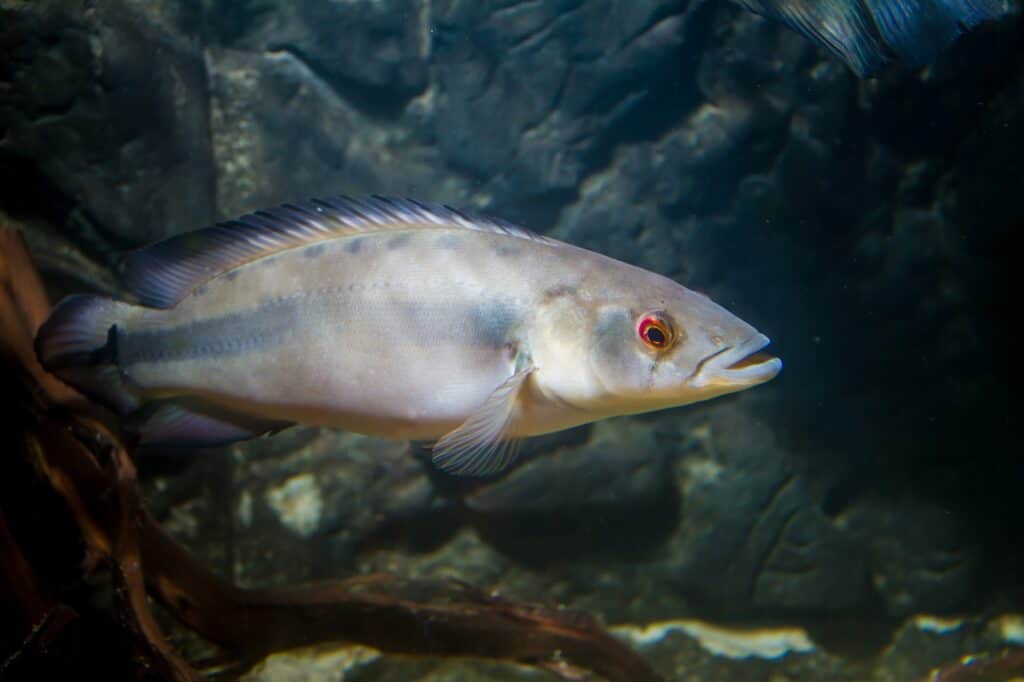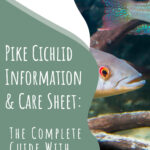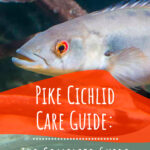The pike cichlid also named the Crenicichla lepidota, is a striking, attractive fish that can make an impressive addition to a large aquarium. Unfortunately, these fish are aggressive and predatory, so they don’t generally make suitable candidates for a peaceful community tank.
However, the enigmatic pike cichlid is popular with many hobbyists who enjoy keeping these interesting fish in a single-species setup. If you think this species sounds like one you would like to learn more about, read on!
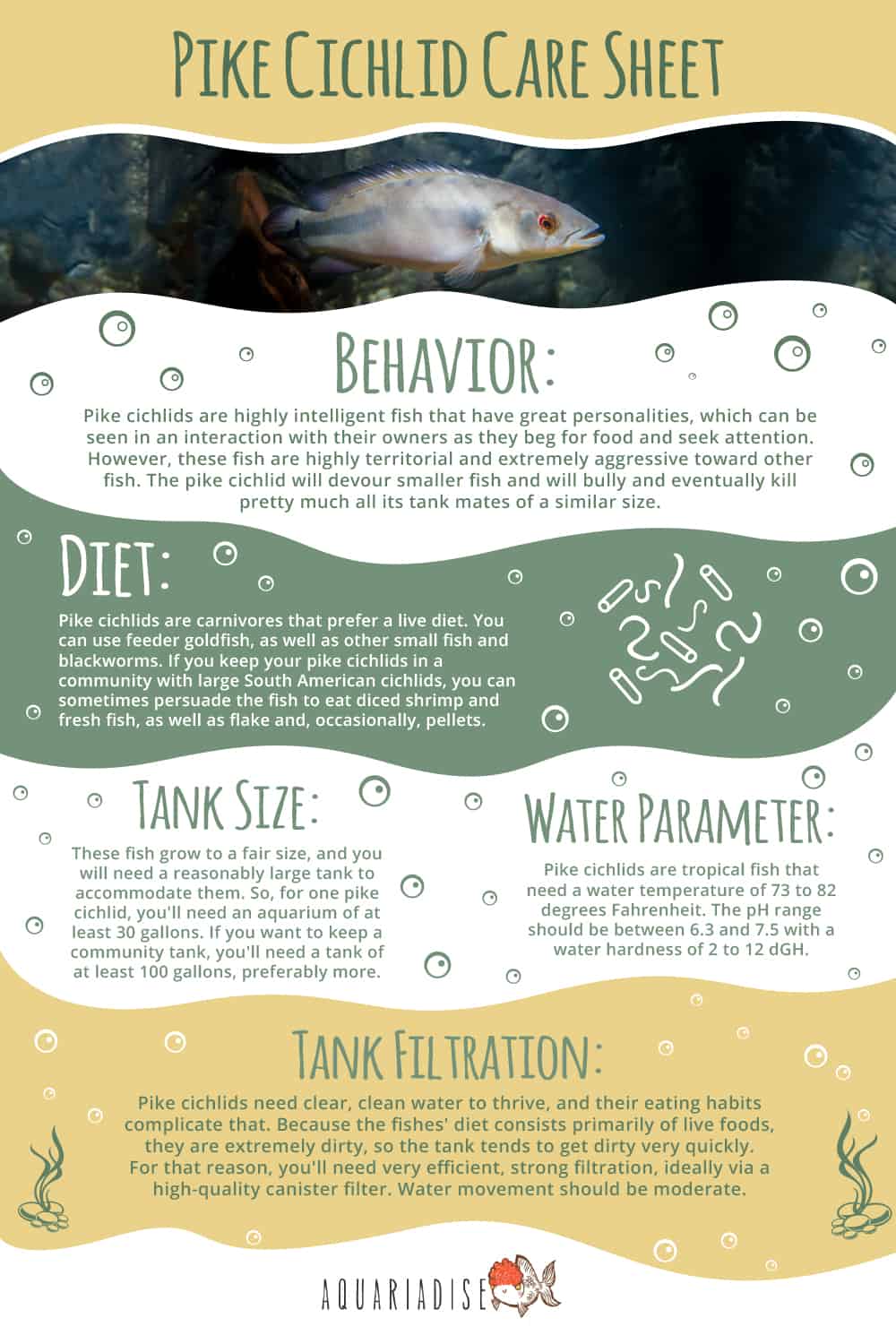
What is a pike cichlid?
Pike cichlids belong to the Crenicichla family of similar fishes, although the pike cichlid is the most well-known in the hobby.
These aggressive fish are moderately hardy and can live for up to ten years in captivity if properly cared for.
Although relatively easy to keep, it’s recommended that experienced aquarists take on these fish, largely because of the pike cichlid’s large size and aggressive nature. Also, these fish are carnivorous, needing a diet that consists almost exclusively of live foods.
Origins
Pike cichlids were first described in 1840 by Heckel. The fish are also commonly called comb pike cichlids and two-spot cichlids.
These fish are found in good numbers in the Paraguay drainage, ranging from Brazil to Argentina and on Brazil’s Rio Grande do Sul coast. Pike cichlids also inhabit parts of the Uraguay River in Uraguay and Brazil, the Amazon River basin, and the Guarpore River tributaries in Brazil and Bolivia.
Habitat
These tropical fish are predatory hunters, living in heavily vegetated habitat, where they lurk among the plants, rocks, and beneath ledges waiting for small fish, insects, and worms to grab.
Pike cichlids are not considered to be endangered as they enjoy wide distribution and are resilient to many of the environmental changes that have recently affected their natural habitat. Although wild specimens are collected for the trade, the species’ numbers are still good, and the population’s status is regarded as stable.
Pike cichlids appear on the IUCN Red List as being of least concern.
What do pike cichlids look like?
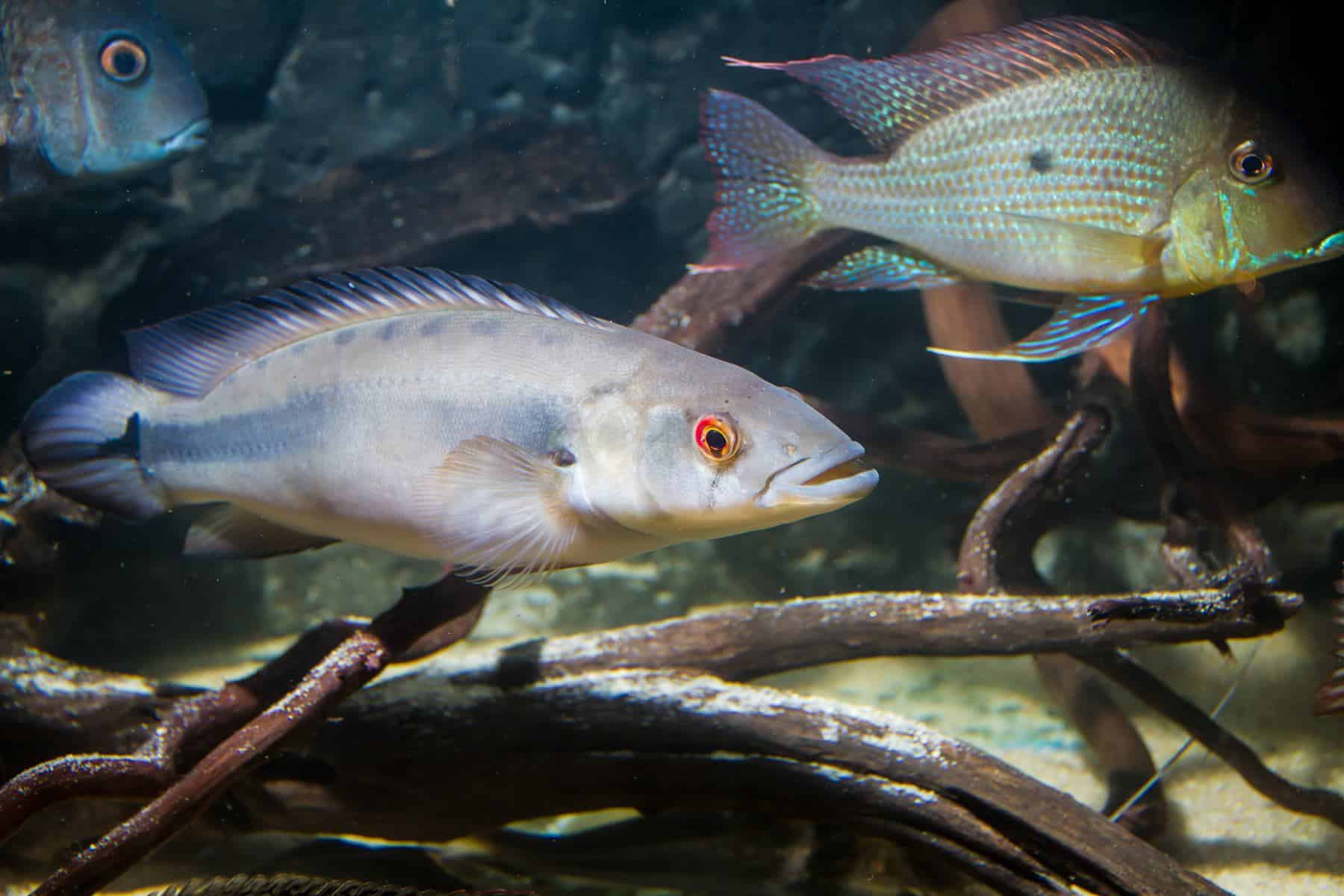
Fish in the pike cichlid family have a torpedo-shaped body and beautiful patterning, although they vary tremendously in size and coloration. Generally, these fish grow to measure up to 7 inches in length, with males being a little larger than females.
Crenicichla lenticulata is light green or blue-gray on the top of their body, fading to a beige or silver shade beneath, having a dark line dividing the body.
The fish’s color depends on where it originates, but all specimens have eight to nine small spots along the edge of the dark mid-body line. When the fish is stressed or excited, those spots extend upward into bands, receding when the fish is calm.
Two spots on the line are larger than the others and have reflective scales. The first of these is a shoulder spot, and the other is a smaller spot framed in gold that is only seen on male fish, appearing at the base of the caudal fin.
The fish’s eyes are bright red, and in some specimens, the fins may have red and blue accents.
Males versus females
It’s relatively easy to tell the difference between male and female pike cichlids. Males are larger than females, have no white on their dorsal fin, longer finnage, darker coloration along their back, and shiny scales surrounding the spots on their back.
Female fish are smaller with a white pattern on the dorsal fin, a pale red to orange belly, and a metallic green sheen to the body.
Defense mechanisms
Like all cichlids and some saltwater fish, including parrotfish and wrasses, pike cichlids have a set of pharyngeal teeth in their throats, as well as regular teeth.
The fish also have spiny rays in the rear of their pelvic, anal, pectoral, and dorsal fins that help to discourage attack by predators. The remainder of the finnage is soft, enabling precise positioning in the water rather than fast swimming.
Pike cichlids have one nostril on either side of their head, allowing the fish to “smell” the water, which they do by sucking water in and expelling it again, after having first sampled the scents that the water contains.
Behavior and tank mates
Pike cichlids are highly intelligent fish that have great personalities, which can be seen in an interaction with their owners as they beg for food and seek attention.
However, these fish are highly territorial and extremely aggressive toward other fish. The pike cichlid will devour smaller fish and will bully and eventually kill pretty much all its tank mates of a similar size. Essentially, these guys are not suitable for life in a community tank unless their companions are large, semi-aggressive species that can defend themselves.
Silver dollars, large South American cichlids, and tinfoil barbs may be suitable as tankmates, as long as they don’t kill your pike cichlid. It’s a delicate balancing act.
Unfortunately, shrimp, crabs, and even snails may also be regarded as a food source and shouldn’t be kept with pike cichlids.
Pike cichlid care guide
If you like the idea of keeping pike cichlids, here’s what you need to know about their care requirements.
Tank size
These fish grow to a fair size, and you will need a reasonably large tank to accommodate them. So, for one pike cichlid, you’ll need an aquarium of at least 30 gallons. If you want to keep a community tank, you’ll need a tank of at least 100 gallons, preferably more.
Although pike cichlids are primarily bottom-dwelling fish, they are known to jump, so you will need a tank with a tight-fitting lid.
Filtration
Pike cichlids need clear, clean water to thrive, and their eating habits complicate that. Because the fishes’ diet consists primarily of live foods, they are extremely dirty, so the tank tends to get dirty very quickly.
For that reason, you’ll need very efficient, strong filtration, ideally via a high-quality canister filter. Water movement should be moderate.
You will need to carry out weekly partial water changes, as well as deep-cleaning the substrate with an aquarium vacuum to get rid of things like fish waste, uneaten food, and general detritus.
Decoration
Pike cichlids need lots of hiding places, especially as juveniles, as they can become stressed if they feel unsafe. Once the fish are mature, they will spend more time out in the open water.
Equip your tank with wood, rocks, caves, and overhangs where the fish can hide away, and use lots of dense planting, too. Floating plants are a good idea, too, as they provide plenty of shelter while keeping the fish out in the open where you can see them.
The lighting in the tank should be fairly subdued, and floating plants can help to achieve that. A sandy substrate works well, as it mimics the fish’s natural riverbed habitat.
Water parameters
Pike cichlids are tropical fish that need a water temperature of 73 to 82 degrees Fahrenheit. The pH range should be between 6.3 and 7.5 with a water hardness of 2 to 12 dGH.
Diet and nutrition
Pike cichlids are carnivores that prefer a live diet.
You can use feeder goldfish, as well as other small fish and blackworms. If you keep your pike cichlids in a community with large South American cichlids, you can sometimes persuade the fish to eat diced shrimp and fresh fish, as well as flake and, occasionally, pellets.
You should feed your pike cichlids twice a day. If you’re using feeder fish, be sure to quarantine them for at least a week and treat them for parasites before feeding them to your cichlids. Do not put water from feeder fish tanks into your main display tank!
Breeding
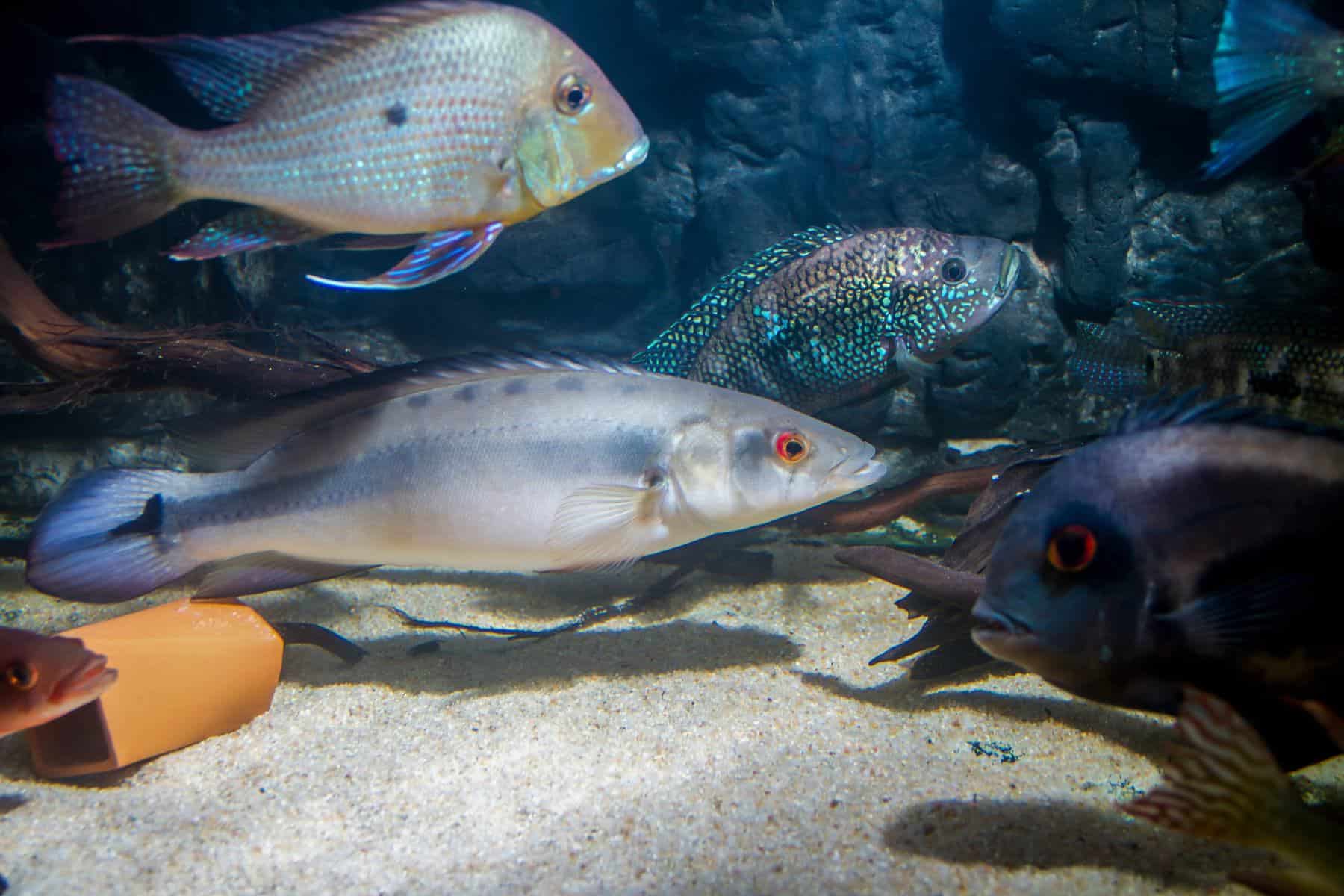
Pike cichlids are moderately easy to breed in captivity.
To do that, you need a mated pair. Keep six or more juvenile specimens together for a few months and allow them to pair up naturally. It’s relatively easy to tell the sexes apart by their color and markings as they grow. Male fish reach maturity at around 7 inches long and females at 5 to 5.5 inches.
Spawning tank and spawning
The water in the spawning tank must be very clean and well-maintained.
Increasing the water temperature to around 79 degrees Fahrenheit and providing the pair with a protein-rich diet can encourage spawning. The pH level in the spawning tank should be around 6.
The spawning process can be quite violent and begins with the female fish who adopts an area of the tank as a potential breeding site. At that time, it’s best to remove any other fish that you have in the tank.
The fish will excavate a pit beneath a piece of wood or rocky overhang, and the eggs are laid on its ceiling. The eggs take around four to five days to hatch, depending on the temperature in the tank. The female fish cares for the fry while the male guards the territory until the youngsters are free-swimming. At that point, the male assumes responsibility for raising the brood.
Health and disease
Pike cichlids are not prone to any particular diseases, and they remain healthy as long as you keep the water in the tank clean and feed your fish a healthy diet.
However, there are a few common fish diseases that can affect pike cichlids, including:
White Spot Disease
White spot disease is probably the most commonly seen disease of tropical freshwater fishes.
White spot is also known as ich, named after the parasite that causes the condition, Ichthyophiruis. Fish suffering from ich begin to show symptoms by flicking or rubbing themselves against solid surfaces within the tank. As the disease progresses, a sprinkling of tiny white dots appears across the fish’s body, fins, and gills.
White spot is easy to treat if you catch it early. Simply raise the water temperature in the tank to around 82 degrees Fahrenheit, and dose the water with an ich medication that you’ll find in your local fish or pet store.
Flukes
Flukes can find their way into your tank on feeder fish and with other live foods. Flukes are various species of aquatic parasites that attach themselves to the fish’s body and gills.
Fish infected with flukes rub against the substrate or tank decorations in an attempt to remove the parasites from their bodies. You may also notice excessive amounts of mucus over the fishes’ bodies.
Flukes are treatable with antiparasitic medication that you can buy from most fish and pet stores.
Bacterial infections
Fish that are stressed or injured often succumb to attacks by various species of bacteria that live within the aquarium.
If your pike cichlids have red patches, ulcers, or sores on their skin, that’s probably caused by a bacterial infection and can be treated with an antibacterial product from a fish or pet store.
Fungus
Fungus appears as a fluffy, cotton-like growth on the head, body, and fins of the fish. You can easily treat fungus with an over-the-counter antifungal treatment.
Preventing disease
Protecting your fish from these common ailments is pretty straightforward. Never introduce new fish or feeder fish into your tank without first quarantining them for at least a week to ten days.
Finally, wash any new plants or decorations in water containing an antibacterial treatment before adding them to your main tank.
Availability
It’s not common to find pike cichlids for sale in fish stores, although you can obtain these fish quite easily through online dealers and breeders.
You can expect to pay less for a juvenile specimen, and more for a larger, more mature fish.
In conclusion
The pike cichlid is an unusual, medium-sized tropical fish that is only suitable for a community tank that contains other large, semi-aggressive types that can defend themselves.
Although these cichlids are interesting and intelligent, they are best-suited for aquarists who have experience in caring for more demanding species. These large fish are aggressive and need a diet that consists primarily of live food. You must also be prepared to devote lots of time to tank cleaning and maintenance, as these are very dirty fish.

